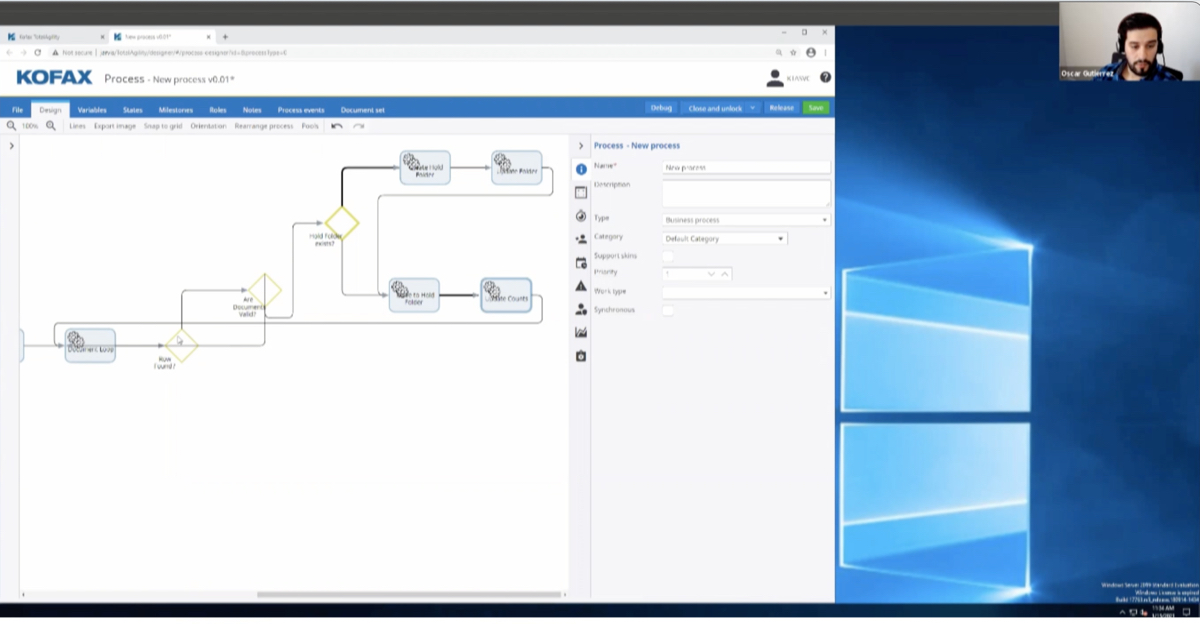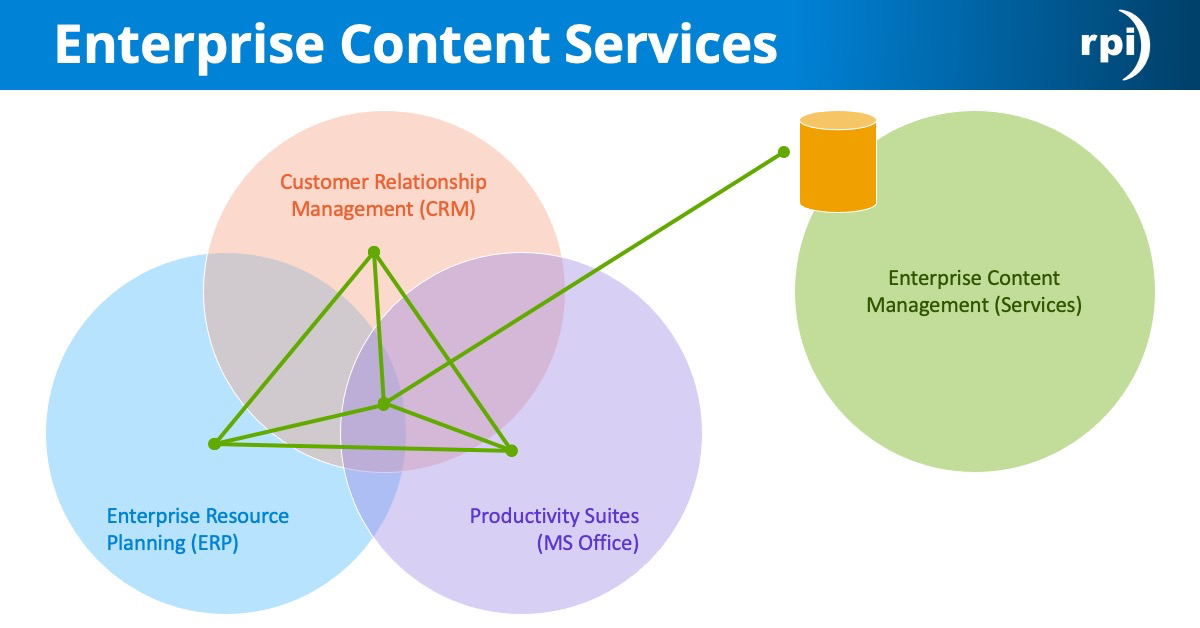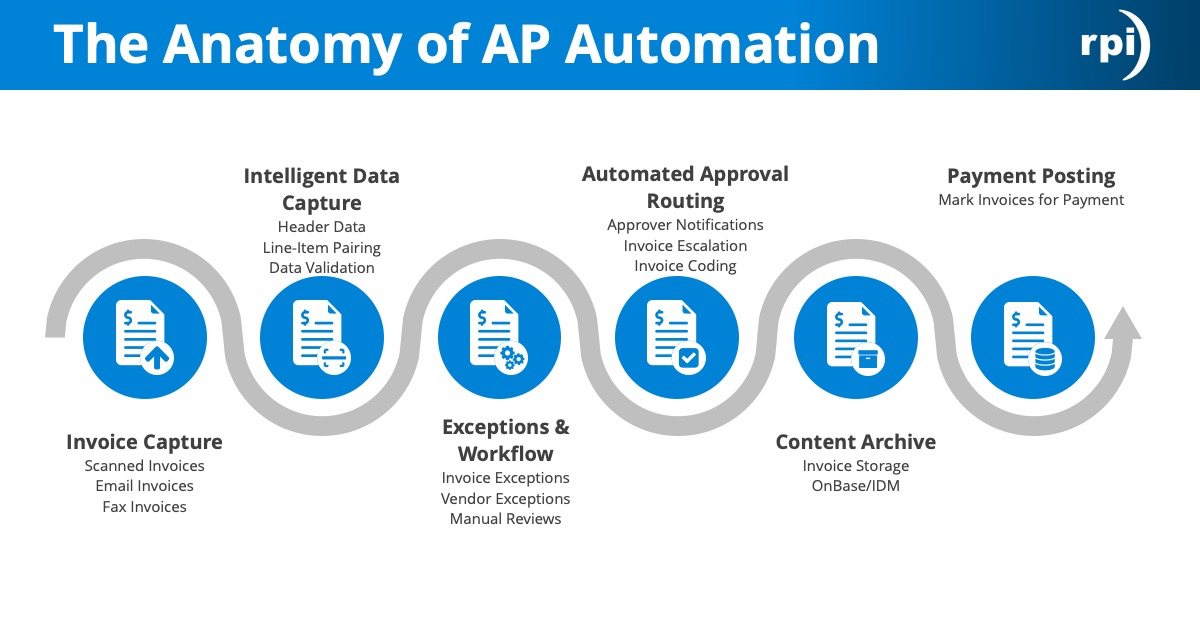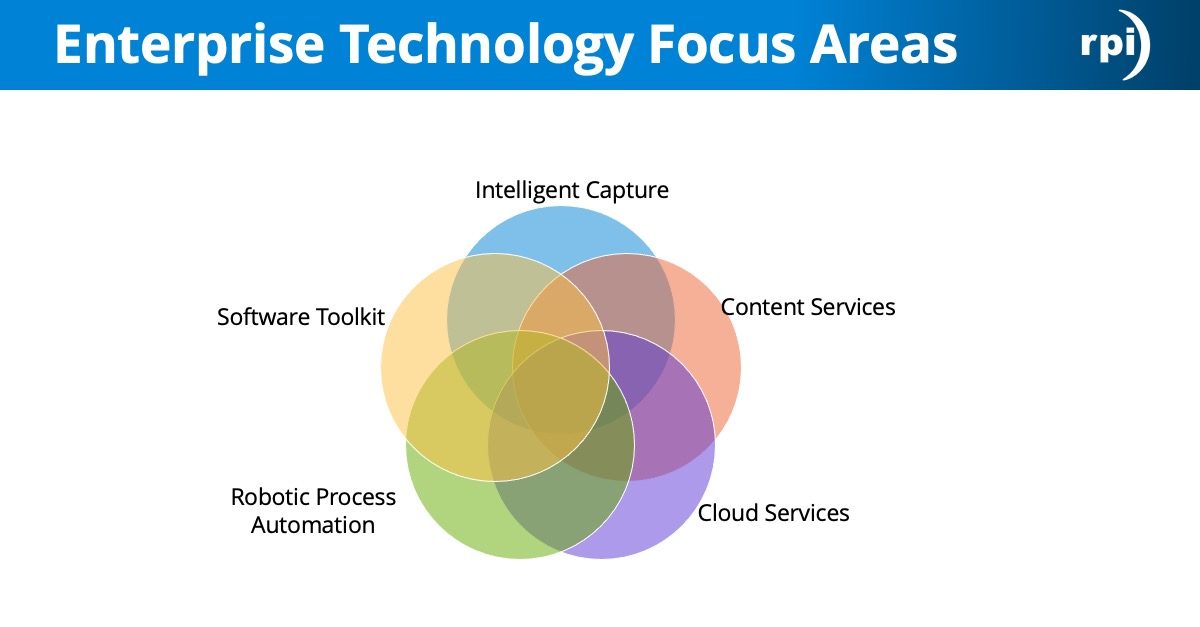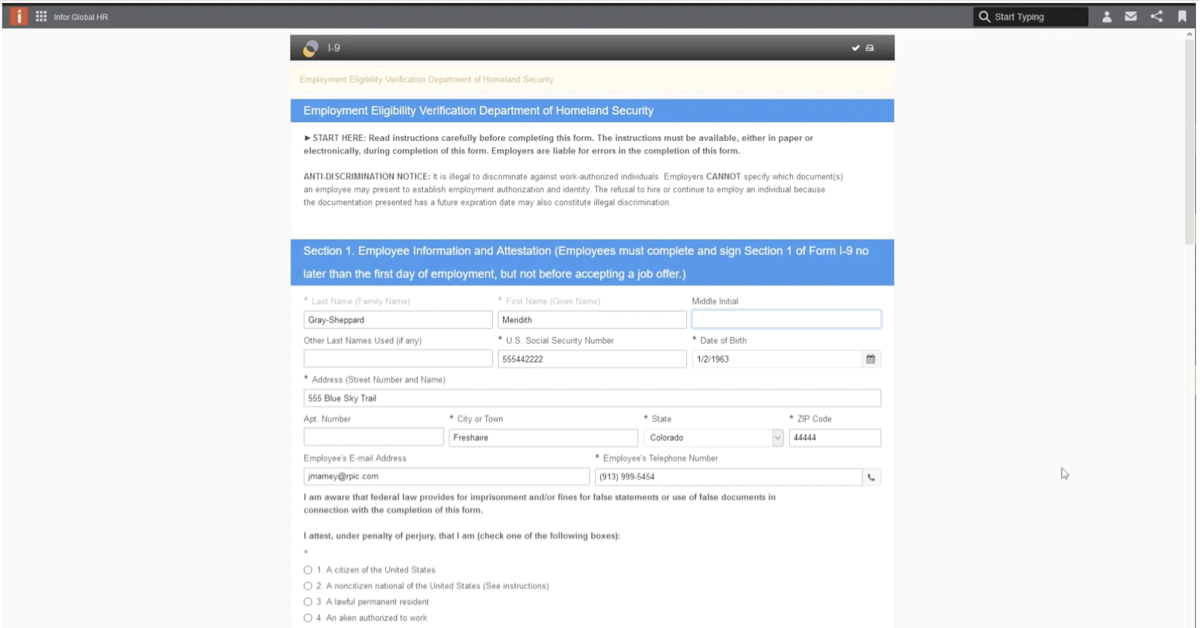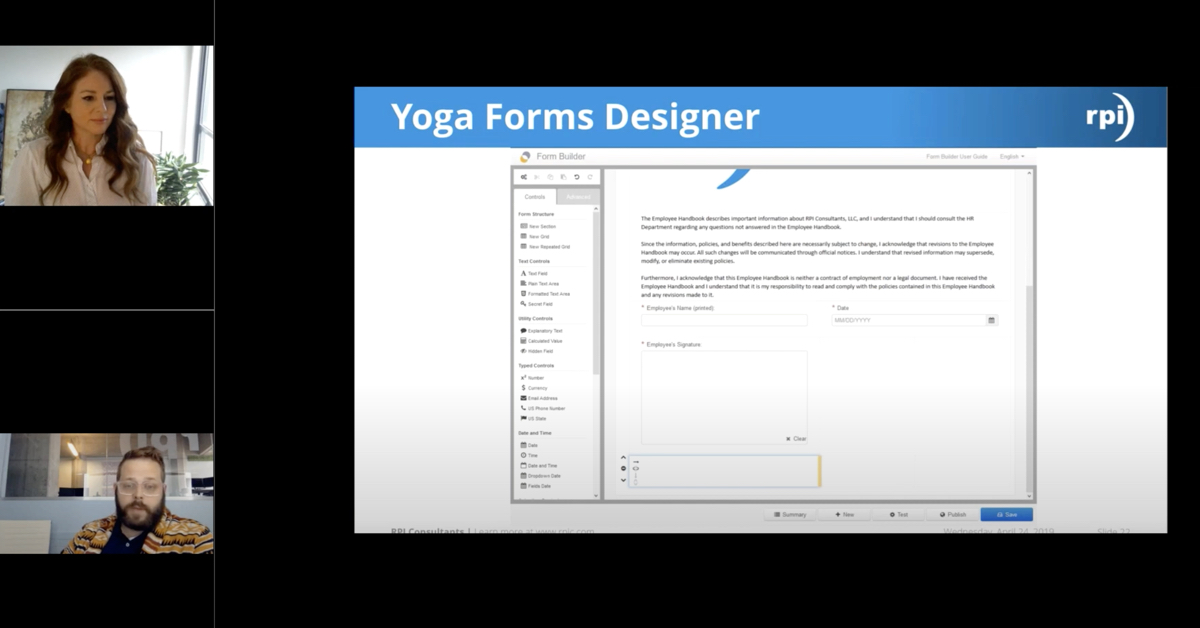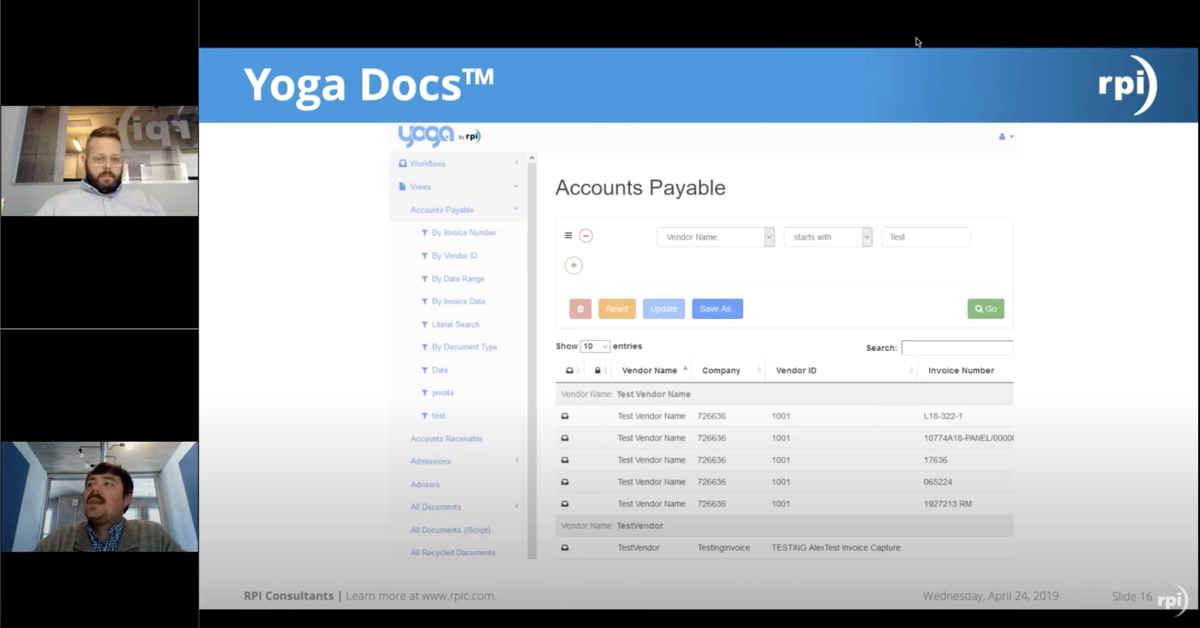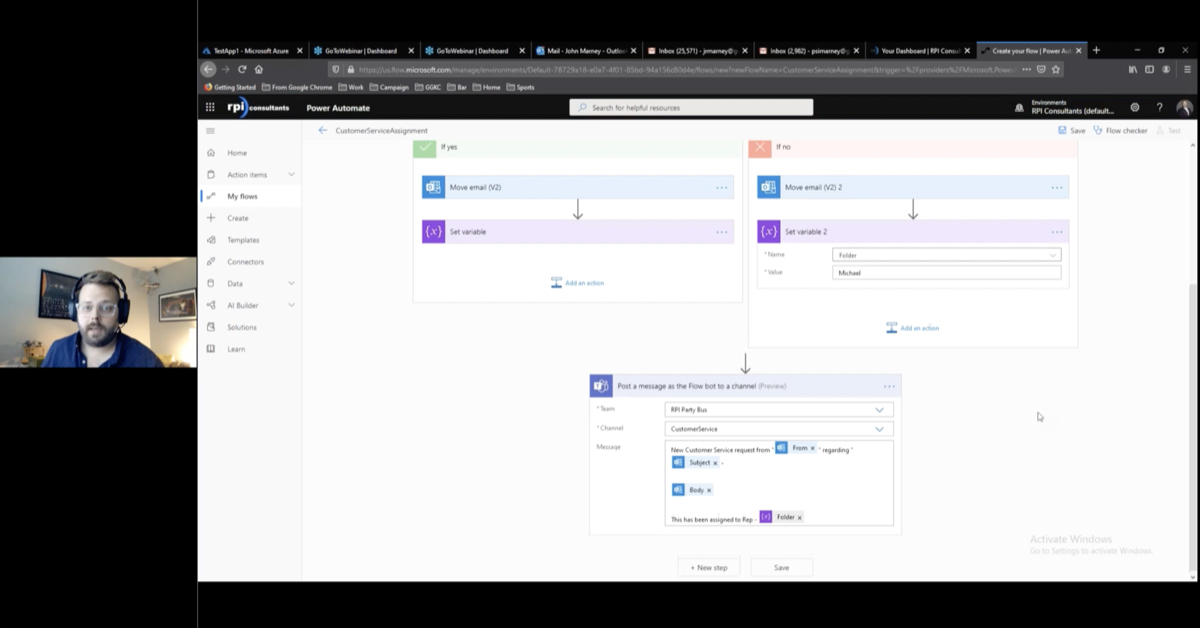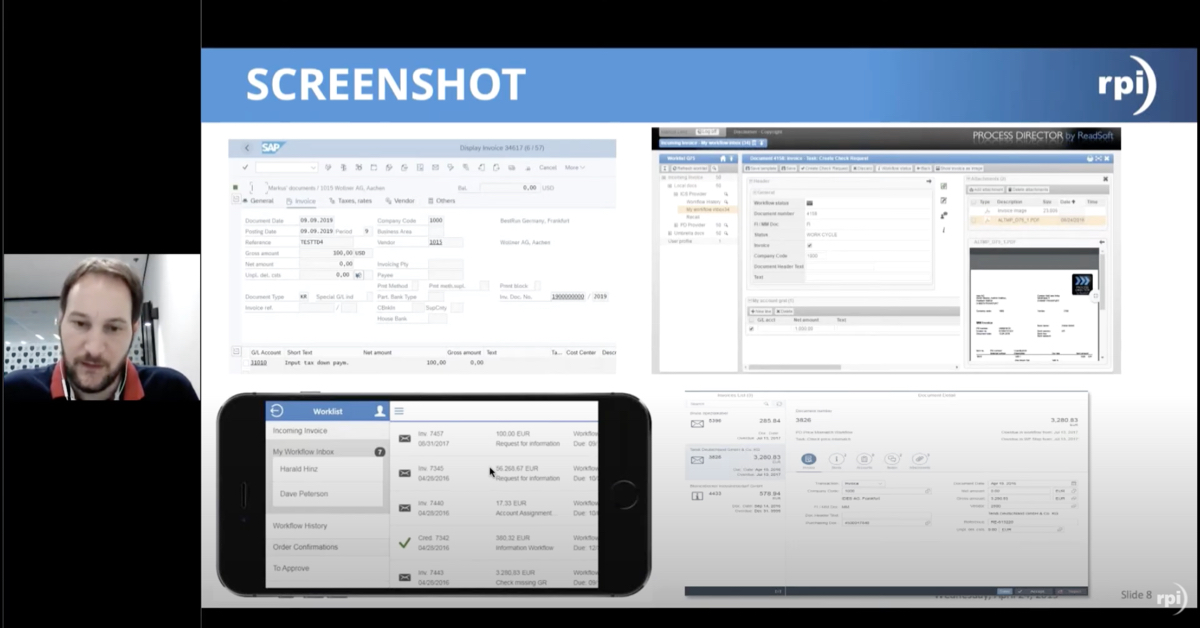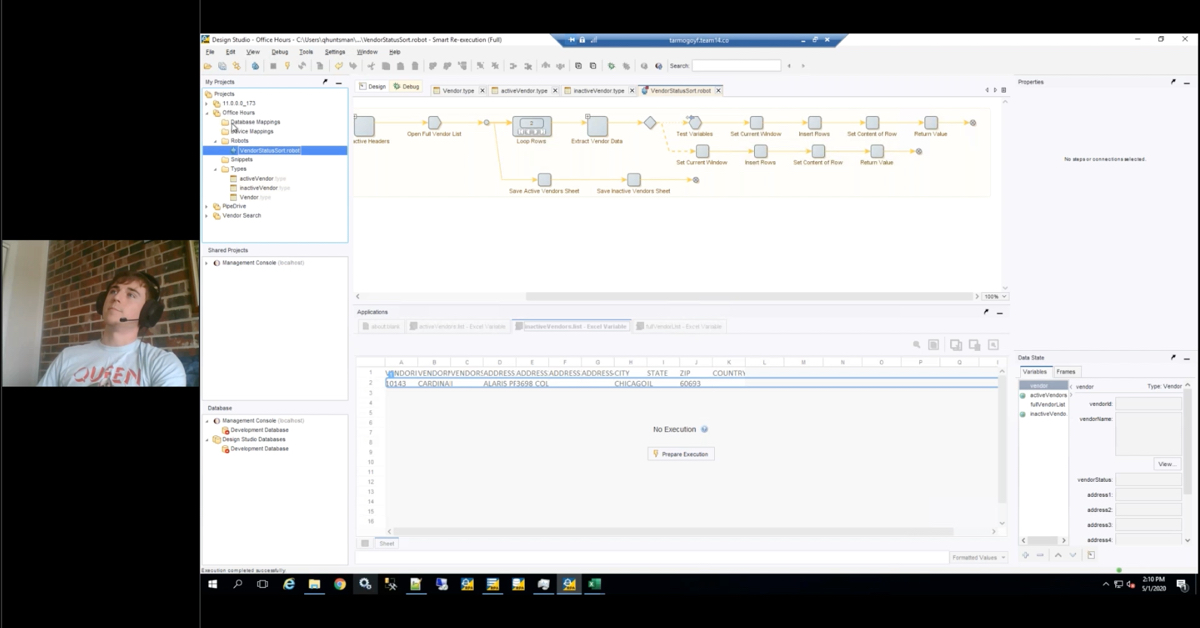Kofax Solutions for Accounts Payable
Learn how to utilize Kofax Capture, Kofax Transformation Module, and Kofax Total Agility to transform your AP process from manual data entry to automated data entry through the use of the most advanced OCR technology. All of this integrated with Perceptive Content or your ERP for a smooth AP process.
Transcript
Geoff:
Hey good morning or afternoon depending on where you are. This is Geoff Lilienfeld with RPI Consultants. I am one of the partners at RPI and also manage our Imaging, Strategy and Technical Services practice. That is primarily consisting of Perceptive Content, Perceptive Intelligent Capture, as well as Kofax, KTM, Kofax Capture and soon to be Kofax Total Agility. With me is Mike Friel. Mike Friel is a Kofax KTM, KTA and Capture expert as well that we work with, with quite a few engagements. Just to give you a little bit of an overview as to what it is we’ll be doing here, we’re going to talk a about Kofax and how it relates accounts payable. Then we’re going to jump into a live demo that Mike is going to perform. Quick background on RPI, we got our start back in 1999 as experts in the procure to pay lifecycle space. As it stands currently, RPI is kind of focused into two groups. One group being Lawson. There’s about 60 to 65 Lawson consultants. The second group is the one I manage which is that Imaging Strategy and Technical Services.
Again, Perceptive Kofax. We’ve been working with Perceptive for 16 years now and Lawson for 12 years. Again, start being AP shared service centers but of course the imaging space has evolved quite a bit. With our focus on imaging, we really focus on two things. Or two core fields. One being the actual content, that’s where Perceptive Content/ImageNow comes into play. The second being Intelligent Capture. That’s the OCR piece that we’re going to be talking about today. The two main players in this space, there’s Perceptive Intelligent Capture and Kofax KTM. Depending on your various business needs, each one has a role and a good time to leverage them. Perceptive Intelligent Capture is highly customizable and requires or can have a lot of custom backend coding. For extremely complex projects, Perceptive Intelligent Capture can be a great fit. Kofax KTM is a great solution for processing forms and invoices, structured data as well as invoices. It comes with a great user interface and is very easy to train and to just keep up and running and learning invoices. We’ll show you that.
There’s a few benefits of going into AP automation. Of course, when we think about OCR, one of the main things that we think about is data entry. Not having to manually key in a whole ton of data. Once we get things from OCR, we can get into an approval workflow. Rather than having to carry invoices all over the place, we can actually have invoices automatically route to the appropriate approvers. Be approved with a couple of clicks, and we know that the right people are approving every invoice. It also creates a nice audit trail. One of the things we look for especially looking over approvals is [inaudible 00:04:09].
Mike:
Geoff, I think we lost your audio.
Geoff:
I will switch over. Is that better?
Mike:
Much better.
Geoff:
Okay. One of the things that we can look for also is that straight through processing. We look for a three way match. Once we have that three way match, then we know okay, we don’t need to further look at this and we can cut the check and save a whole bunch of time there. Of course, there’s also taking advantage of payment terms so that we can get those discounts as well as the ability to retrieve documents easily later on. Keeping in mind that we can match documents together. If we have an invoice, we can easily with a single click, pull up the packing slip, pull up the PO. Have everything right there. Then obviously, the endgame is that all of this has to integrate with your ERP system. In a very common scenario that we might be looking at, what we might be doing is bringing the data, scanning the invoices into Kofax KTM or KTA, passing the data to Perceptive Content, performing approval routing inside of Perceptive Content. Of course, it doesn’t have to be Perceptive Content. There are other document imaging systems as well. Ultimately, once that invoice is approved, we want to pass that data into the ERP system. Whether that’s Lawson or Peoplesoft, Dynamics AX, NetSuite, whatever it is that you’re using, we’re able to then pass that data to your EPR system and ultimately get the check cut.
If we look at why it is that organizations go to this type of a solution, it’s not shocking to see that one of the top things that we want to do is reduce the cost to process an invoice. These things can get pretty expensive. If I jump forward to the next slide real quick, we can see for some organizations, it costs as much as $26 to process an invoice. You really can get that down quite a bit. Not shocking, the more invoices that an organization is processing, the more that you can expect to be saving. Especially if you have very high volume vendors where you’re getting a whole tone of invoices from the same vendors. Once the system gets trained on that vendor, you can really start moving through those invoices and eliminating a lot of the manual keying. If we go back real quick, there’s also just that invoice handling process. Not having these things floating all over the place. The ability to have that cash management take advantage of the payment terms.
What we generally see with our clients is that we want to have this full automation. From the time that we receive that invoice. Hopefully that’s coming in via email, that we’re then sending that through a work flow and properly having that approved and making sure that all of the GL coding is correct. With some of our larger clients that have multiple locations, especially very common in healthcare, there also a big piece of this around centralizing the AP process. As opposed to having invoices being processed all over the place, at satellite sites or various hospitals, we want to have one central AP department that’s processing these invoices. The AP automation piece, not only provides the automation, but it also provides the ability for us to get invoices approved across various satellite locations. As we discussed, there can be some very large cost savings to all of this. What I’m going to do now is pass over the com here to Mike who will go ahead and show us what this looks like.
Mike:
Here we go. Can you see my screen Geoff?
Geoff:
Yep, I think we’re good Mike.
Mike:
Perfect, perfect. Thank you so much. Well let me add my good afternoon or good morning to everybody out there. As Geoff mentioned, my name is Mike Friel. I’m with a company called New Wave Technologies and we are a technology partner with RPI. We do a lot of work together. They come to us for all their Kofax software scanning, things like that. We’re a major distributor. A little bit of my background is, I used to work for Kofax. I’ve been in the document capture, document management industry for, gosh it’s got to be 20 years from now. At New Wave, I specialize in really one thing, that’s importing the Kofax line and helping our partners with situations just like this, where I’ll do webinars. I kind of throw this graphic up because there’s a lot of people who are completely unfamiliar with Kofax Capture. It is a world class document capture application, it’s been around gosh more than 20 years now. Then laid on top of Kofax Capture is something Geoff talked a little bit about which is, Kofax Transformation Module, KTM. KTM essentially extends the capabilities of Kofax Capture by adding things like document classification and automated data extraction. There’s a number of applications to this technology.
The ones that you’ll see today are probably the most ubiquitous ones in the industry is invoice processing solutions. Most companies do some form of invoice processing regardless of the size of the company. What you’re going to see from a work flow standpoint is, I’m going to scan a bunch of invoices. In reality, I’m actually going to import them in, they’ve been scanned ahead of time. Then we’re going to go to this server piece, this KTM server piece where they’ll be classified and extracted. Also worthy of note, and Geoff just spoke about it is the fact that I’m seeing now that 25% of invoices have never been in paper form. They’re sent maybe via an email attachment as a PDF file to companies to process that way. Kofax is equally adept at the ability to monitor a mailbox or bunch of mailboxes or things like that and bring an invoice in just by getting those scanned locally.
After we extract the information from that invoice, we’re going to go to the validation module where we’ll put a set of eyes on low confidence fields. This learning server is an amazing piece of technology that I’ll get into during the demo. Then release, or export, where think of Kofax as really just the front end capture and classification extraction piece. As Geoff mentioned, then the ability to feed Perceptive Content or any ERP or ECM out in the marketplace. Kofax has what we call export connectors to many, many different platforms out there. Although you’ll see this running on my laptop standalone which is a perfectly valid configuration, this can scale to the high heavens. I spent a good deal of time with Iron Mountain who are one of the largest users of this technology. It was not unusual to in a big back file conversion to see 15 or 16 high volume, high production scanners cranking away at millions of images. Again, it scales enormously.
That’s what you’re going to see, we’ll close this down. Again, this is the real live software. This is no smoke and mirrors. I’m going to launch and application called Kofax Capture Batch Manager. That’s what you see now. Think of this as a supervisor’s snapshot if you will, of the system. I don’t have any batches in progress. Again, back in the Iron Mountain days if I launched this, it was not unusual for me to see 100 or a couple hundred batches in play. The status of them, what batch class it is, and things like that. I’m going to create a batch now. This is my batch creation dialogue. Here’s all the batch classes that I have in play at the moment. I’m just going to select the Kofax image processing one. The batch class name just defaults to a date and timestamp. I can call it anything I want, providing it’s unique, that there’s no other batch in progress with that particular name. If there’s things like, part of your doc prep process, let’s say I counted the amount of invoices that we’re going to be scanning. If I say it was 100 invoices, I can place that expected value in this pages per batch. Then at the end of that scan run, if the scan count didn’t meet the expected count then it would flag it and let the scan operator arbitrate what went wrong there.
I’m going to save this, close this. Now you can see that I have a batch in play and it’s sitting in the scan module. I will launch that and I will leave batch manager and bring up the Kofax Capture Scan Module. As I mentioned, this is an application that’s been around for more than 20 years now. As you’ll notice from the user interface, this is a Microsoft fluid user interface. Kofax has gone to great lengths to keep this software very relevant. Anybody familiar with any Microsoft Office product is familiar with the tabs. The idea being, it’s super easy to train people on this. This is such an intuitive user interface. Frankly the best one I’ve ever seen. I’ve used a lot of capture applications in my career. At this point, I’m going to just scan a bunch of invoices. Again, what I said is I’m just going to import them. I scanned them ahead of time.
I’m going to grab a bunch of invoices, open them and this mimics the scan process although it’s a whole lot faster. Here is my batch content pane over here. As a scan operator I’m likely to traverse through the batch to take a look. Make sure the quality of all these images are good. Say in this particular one, you’ll notice a streak there. If I didn’t like that streak, I could pull this invoice out of this output tray of the scanner, place it back in the input tray, maybe trying out a streak filter in Kofax ERS to remove that. Re-scan it and it’s going to go right back into the batch where it belongs. These are really the hallmarks of a very mature capture application. It has all the bells and whistles. It’s graphical in that I can move images back and forth and whatnot. Drag and drop capabilities as well.
As a scan operator, I like the quality of these. I will tell you from an extraction standpoint, I’m going to grab a lot of what we call the invoice header information. The company name, the company it came from, their address, remit to, things like that. I’ll grab a lot of the invoice information obviously. That would be the subtotals, the totals, shipping costs, things like that. Last but not least, I’m going to grab all this line item data. I’m going to grab line item data in every invoice. You can see from a line item standpoint, how varied they are from invoice to invoice. None the less we’ll grab all the line item information. I see line item detail, the requirement for line item detail in about half the deployments that we see. As a scan operator, I like the quality of all these particular images. I can just hit close on this particular batch. I’m probably now in the process of prepping another batch, or getting another batch ready.
In the meantime now, this batch has traveled back to batch manager as you can see. This batch has traveled through the KTM server cue. I’m going to process this, because this takes just a little bit of time. Again, because I’m running stand alone, you’re seeing this process run. In a production environment, this is going to run as a service up on a server. You’d never [inaudible 00:17:55] processing. You’d want to throw a lot of horsepower at it because as you can see from my CPU usage, it’s very high. The first thing it’s doing right now is it’s doing full text OCR on every one of those invoices. I’m gathering every character on every invoice and grabbing that through the optical character recognition. Once I have that all in place, then I’m going to extract information based on the rules that are set up for this particular batch class.
As you can see, it’s not through that particular process and putting in the KPN validation cue. Again, if you recall back to that graphic, this is where I’m going to put a set of eyes on low confidence fields. I’m going to hit process on this guy and now I’m going to become a validation operator. When this launches, let me take a moment. This is a very busy screen. It’s worth it to take a minute and tell you all about this one here. This is the batch and contents pane. As you can see, I created nine invoices out of those ones that I imported in. Any invoice where you see a question mark, means that one or more fields fell below a settable confidence level. I’ll stop at every one of these invoices. Conversely, I don’t even have to stop at four, five and seven, I extracted all of that information and extracted at a confidence level greater than what I set. That’s your batch contents page.
This is your data entry page. I’ve actually broken this into two different tabs. Here’s that vendor information that I talked about and the invoice information. The second tab is all your line item detail. It’s just too busy to have on a single tab. This data entry panel is completely configurable and RPI would find out your requirements and customize the screen including logos, whatnot to meet your specific needs or something like that. Over here is the actual image itself. I will say this, that from a best practices standpoint, and just almost reality. Is that this is an application that lends itself to two monitors. I would isolate this image on its own dedicated monitor and clean up a lot of real estate in the process here. Validation operators hate to scroll. They just hate to scroll, it just slows them down.
Also worthy of note in this invoice information section here is, that you’ll notice there are snippets, these are actually cutouts from the actual image itself. The idea being that a validation operator seldom has to take his or her eyes off of this particular screen. He’s just comparing the snippet to what it actually extracts. Down here is, if it does stop at a field, this is the error pane, it’s going to tell you why it stopped there. Before I get into that I want to take just a moment talk about this vendor information. This is incredibly powerful technology that we’re using here. Here’s all the vendor information that I got off of this invoice. The way I got it was, let’s say for instance you have a vendor master file or a vendor database with all the vendors you deal with. Let’s say there’s 2,000 vendors. So that database has 2,000 rows in it. I’m going to essentially take that Sequel database or ODBC, or Oracle, DB2 or whatever kind of database it is. I’m going to convert it into a text file, a big text file.
Go back to this, if there’s 2,000 rows in this particular database, I’m going to create a text file that has 2,000 rows. The idea being that I have all this OCR information. I have every character on this and I’m going to compare the OCR content of this particular invoice to every one of those 2,000 rows to look for the most hits. For instance, Logical Specialty Corporation, it found that and that’s exactly where it found that, up in that top right hand corner. If I look at the date down here, it found the date, I’m sorry, the address at the bottom of that invoice. City, state, zip. Why would I use a fuzzy database as opposed to doing just a straight Sequel, which I can do, I can just do an ODBC call to this database and find it that way. We mention the OCR process. The OCR process is not an exact science. There’s always going to be OCR errors. In the case of this Logical Specialty Corporation, if I was going to extract that information and then do an ODBC search in that database, let’s say the O in Logical was a zero, it said OCR to a zero. I’m never going to find that marker because I don’t have the proper spelling for this particular vendor.
That ability to search fuzzy adds a level of fault tolerance to this. It’s incredibly powerful technology. I’ve searched these 2,000 rows in milliseconds. I’m going to do every particular invoice that way. This isn’t just limited to vendor information by the way, there’s a lot of applications where you can search fuzzy. Again, just amazing technology. That’s the only time I’ll address that one, every one of these vendor informations I’ve got to do in a fuzzy search. Now we’re going to come back down to the invoice information. Now I’m going to become a real validation operator.
When I launched this application, it stopped right here at this field and told me that the reason it stopped here was that it was only 78% confident that it got the OCR correct on this. I set a confidence level out of the gate at 80%. It fell below that, hence, it’s going to want to validate. As you can see from the snippet, it got it perfectly, I would just hit enter on that. Notice it changes to a green check mark. Next field, 2234, it extracted 2234, what’s going on here? Come down to here and it’s just telling me that guess what? All the information, all these, the subtotals, the taxes and things didn’t add up to the invoice total. It added all that it extracted and guess what? It didn’t come up with that invoice total. The idea is, again, not only do you want to be fast but you want to be incredibly accurate. This is all about speed and accuracy. It obviously missed something here. If I zoom in a little on this invoice, there’s a miscellaneous charge of $5 that it obviously didn’t get. I can come into additional charges, I can just hover over that five, click on it, it populated that field, and done. Okay?
I do this purposely because in many demos I completely forget to show people, particularly if they’re not interested in it. On the line item detail. I create a crazy high confidence level on the description of that, just again, it got it all right. As you can see now, I am out of invoice number one and I’m on invoice number two. You can just tell by the snippet, you don’t even have to refer to the image. You can look at the snippet to understand what happened here is that the two is much darker than the surrounding characters. It just had a low confidence level, it’s only 62% it got it right, but indeed it got it right. Again, it got all the line item detail, which is only a single line. So, I hit that, and now I’m on the third invoice. You can see, if I’m not talking, if I’m just a heads up validation operator, I can probably look through this batch certainly in less than a minute and get complete accuracy, 100% accuracy. Which is really what it’s all about.
A couple things worthy of note on this particular invoice. Notice, this is an invoice from Chief Meter. You can see the date format that Chief Meter works. It employs an abbreviated month, day and year. Regardless of how a date is put on an invoice, whether they spell the month out, whether they abbreviate the month, whether it’s just a numeric month, I’m going to find that. Not only will I find it, I’ll then reformat it into a much more database friendly straight numeric date and we’re going to make it a four digit year. Again, one of the out of the box features of KTM is that ability to locate dates regardless of the format you find them.
Then my next field, I’m coming down to this PO number. Because it’s a required field, it’s not going to let me go past this without putting something in there. You’ll notice there’s no snippet, it just flat out missed it. Again, I’m going to have to come back over to the image and try and figure out where it is and why it missed it. Here is the PO number right here. As you can see, somebody took a pen or a sharpie or something and kind of obliterated the words purchase order number. Well that’s exactly the text that I look for to locate this field. This is not a templated solution. KTM is not a templated solution. What do I mean by that? During the setup process, I didn’t take an invoice from Chief, scan it and say, “Here’s where you’re going to find the invoice number, here’s where you’re going to find the date. Here’s where you’re going to find the PO number, the total.” That’s what a templated system does. Mind you, there’s a place in this world for templated solutions. Typically if you deal with a small amount of vendors.
If I only deal with 40 vendors, maybe 50 vendors, then I’ll take the time and setup a template for each one of those. As in the example I sited in that first one, 2,000 vendors I deal with on a regular basis. There is no way you’re going to want to setup 2,000 templates. That’s where a templated solution will fall on its sword. This is not a templated solution. I look for keywords. In this particular case, I can just hover over that, populate that field and hit enter. Now I’m quickly down to my sixth invoice, all the question marks are gone, sixth invoice. Here again, this is a case where a PO number which is a required field and I didn’t get it. I did this purposely to show you another really cool feature. This is a feature that validation operators love. There’s the PO number and it’s 925. As you’ve been seeing, I hover over and click on it. Well in a heads up image operation, again they’re all about speed and accuracy. Speed is paramount, they hate to take their hands off a keyboard. They’ve got special keys mapped to perform special functions. They are loath to touch a mouse. That slows them down.
In this particular case, I’ll act like a real validation operator and I’m just going to key this number. I see it’s a 925, I’m going to key a nine, there it goes. Notice what happens. Because I have a full text output of all this, I light up every nine on this invoice and they give me a dropdown box. I can get it with that, 92, notice there’s only one instance of a 92 here. Here’s the dropdown box. In two keystrokes, a validation operator has that eight or nine digit PO number. Validation operators love that feature, again they’re all about speed. With speed, they need accuracy. That really helps them out.
Then lastly, these last two invoices are both from the same vendor. A vendor called Fluid Power. As you can see from this particular invoice here, I know we do business with them because they’re in my vendor database, Fluid Power. As you can see, it did just a terrible job of extracting information off of this invoice. The second one is the exact same as this. Why is that? What happens is, and this is a real world situation. Fluid Power recently changed the layout of their invoice. In paper form this probably looks really neat, it’s probably a really good looking invoice in paper form. In this day of automated extraction, it’s a terrible design in that they’ve hidden all the words that I search for like invoice date, PO number and things like that behind gray scale. I was unable to OCR that. Again, that’s kind of a real world situation.
Now I’m going to show you the power of the learning server. The validation operator will say, okay we’ve got to grab this date. Notice there’s some spaces in there but when I tab out of that, spaces are removed and I format that date. Now come down to that subtotal field, click on that. The tax field, click on that. Shipping, 384, got it and then a total of 200, got that. Now I’m on my last invoice. Again I mentioned, it was from Fluid Power. Notice in my batch contents page here, that question mark on invoice eight now changed to a plus sign. That plus sign indicates that I am going to take this Fluid Power invoice and through that learning server, I am going to update the knowledge base. You’ll see it on that last one as well. We’ll quickly do the same process on this last one. Grab the date, come down. Notice when I hover over this subtotal, people ask me, “Why do you rubber band or rope and wrangle some fields and just click on others?” I wouldn’t get it all in this particular case because there’s a space. The OCI process introduced a space right there between the eight and the nine. When I tab out of it, it removes that space and tabs it out.
Now if I come into tax, hover over that, I got it all. Shipping, same thing. Lastly, the invoice total. Got that one, okay? Now as you can see, there is a second check mark. These two invoices will be sent by way of that learning server to update the knowledge base. Before I do that, before I close this batch out, I’m going to show you one more feature that can help Kofax Capture KTM all on its own. If I go back to invoice number one, which has the most line item detail. Let’s say I just wipe it all out. I’ve just wiped out all that line item detail. Because it’s a requirement, I’ve got to grab it. You can think of how onerous that would be to have to key in this information. If you watch what I can do now, I can add a row and essentially, much like that Fluid Power invoice, I’m going to bring it in on the fly. I’m going claim the quantity, that’s how much they shipped, the item number, I’ll just rope that. Description, similarly. Just going to rope that guy there. My unit price at 119 and then the total price, 238.
I’m not going to torture you and do every one of those rows, it’d be a little quicker but not a whole lot. Kofax has this notion of interpolation, and it’s going to look for a similar pattern and grab all that. Including that page, page two down here if I look at that, that’s page two. It does that for how long that invoice is. It grabbed that. Another incredibly powerful feature. This isn’t limited to invoices. Think of anything that has lots of table information. Geoff talked about healthcare. When you get into things like explanation of benefits and things like that, there’s tons of table data. Financial statements for banks or insurance. Huge amount of table data. When that information has to be keyed, this is an incredibly fast way to do it. At this point I can close this batch and now I’m back to Batch Manager and you can see it sitting here in my KTM learning server.
This too is an unattended process, you’d never see this in production. This is very fast though. It’s going to take those two Fluid Power invoices and update the knowledge base for that learning. Lastly again, another completely unattended task, which is export. This is where I’m going to take it out of Kofax and maybe put it into Perceptive Content or an ERP or maybe both. I can do multiple releases simultaneously if I wanted to. In this particular case I’d hit process on this and here’s where it’s going to take the meta data and those images out of Kofax and put it into the ERP or Perceptive Content or whatever backend you happen to support. Now you can see that’s completely out of Kofax.
Let me show you that again, that power of that learning server. I’m just going to really quickly put a batch into play. Let’s say it’s a month later and I’m doing a pile of invoices again. Let’s just grab three of these, open this. Low and behold, it’s Fluid Power. I’m not going to fool you, the software saw those two. Those got processed the first time through. Hasn’t seen this one though. This is a third one I kind of purposely leave out. Again, it’s a month later and you get a few more invoices from Fluid Power. I’m going to close that and once you hit process again, KTM server. This is where I’ll do the first thing, full text OCR. Once I’ve got all that full text OCR, then I’m going to do the extraction based on the rules that I’ve setup.
Again, this is pretty fast because it’s three one page invoices. It goes pretty fast anyway. Now I’m in KTM validation where I’m going to put eyes on low confidence fields. In this particular case, there are none. Everything passed at a greater confidence level but I’ll launch it anyway to show you. Now date, you know exactly where to find date now, know exactly where to find the subtotal here and the total. Again, that’s the power of that learning server. If you look at invoicing in general, most companies will tell you that 80% of invoices come from 20% of their vendors. It just kind of a rule out there, that there are just some vendors you deal with on a much more frequent basis. On that 80/20 rule, you’re going to have companies like RPI come in and what they will do is train the system on that 80% it’s going to see all the time. Maybe let that learning server learn those 20%. The more invoices you process over time, the bigger that knowledge base becomes and you’re doing less and less validation. It is really, really incredible. Incredible feature, incredible technology, that notion of a learning server that just gets better over time.
At this particular point, same process. Which is now saving to the learning server because it didn’t train on anything, it’s going to pass through this. It’s not going to pass the knowledge base or anything. In this particular case, and then lastly export, same thing. It is now out of Kofax and into the ERP. That was a very fast demo of some really incredible technology. Geoff, you can grab control again here. I think you’ve got a couple other slides. If we open up for questions, I’m going to be here til the end of this. No worries there.
Geoff:
Yeah, awesome. Thanks Mike.
Mike:
My pleasure.
Geoff:
That learning server, that’s really one of the things that makes Kofax what it is. The fact that we can learn invoices on the fly like that. Like Mike mentioned, if you had some super high volume vendors, we may take a little bit extra time to get a little bit more information. Just to make sure that we’re getting even higher rates. Yeah, the ability to just pass those invoices and then in the future, it knows exactly where to look. That’s a huge, huge benefit. At any rate, let’s talk about how we help clients evaluate whether or not Kofax is a good fit. It’s not a good fit for everyone of course. You do want to have a good volume of invoices that you’re processing. If you’re processing 1,000 invoices a month, it’s probably not going to be a huge savings for you.
The things that we really look at are, what is that volume? What is your current cost of processing invoices? Different markets definitely have different expenses. How many FTE’s are currently involved in your process? Again, we talk about those volume vendors. Sometimes FTE’s can be relocated into other roles off of just being able to not have to manually key a few vendors if you’re dealing with those high volume vendors. Then the other thing too is those early payment discounts. Do you get those 210 net 30 terms that you never take advantage of and you could be getting a couple percent discount from a lot of your vendors? Again, it’s so much faster to process invoices once you get this type of a system in place. You’re not spending the time keying, you’re not pushing the paper all over the organization trying to get a bid approved. All of the keying is done automatically. All that you’re looking at are the exceptions. Then all of the approvals are done automatically as well.
Especially with PO invoices that then don’t even really require approval. Just to go back to how we can help in this process, definitely, first off, if you have any questions right now please feel free to ask them. I am watching that. We don’t have any thus far. Definitely please feel free to type in any questions that you have. We assist with the full Kofax design and implementation. We’ll come in, we’ll sit down with you to understand your business process. Like I said earlier, [inaudible 00:42:06] experts. We are not just software people. We really understand the full lifecycle of an invoice and what an AP system looks like. We’ll sit down with you and take a look at your current business process and help you understand what a fully optimized process might look like and what best practices are out there. We work all over the place in tons of different industries. It’s pretty unlikely that you have something we haven’t seen before.
Like I said, we’ve been doing this since 99 working in the P to P space. Working with this type of software since 2001. Outside of Kofax, we also do a lot of perceptive eForm and iScript development, workflow design and redesign. If you’re needing to upgrade your Perceptive Content software, if you’re on 6.7 you’re hitting end of life in June. You got to get that done. Of course, we also do Kofax upgrades and then both Perceptive and Kofax health checks just to make sure you are getting the most out of the system. Security audits, migrations, and then we do, do a lot of clinical integrations, especially with Epic. Any of this type of stuff, please definitely feel free to reach out to me. Thus far, it still looks like we don’t have any questions. I am not going to make up any questions. Oh, I apologize, we actually do have two that just came through here. Does the knowledge base work better with Total Agility?
Mike:
No, total agility is just a different platform. In fact, KTM, total agility, KTM has been ported over to Total Agility. In fact, it uses the same underlying technology. Works just the same. For anybody unfamiliar with KTA, Total Agility or Kofax KTA, think of it as almost a BPM, a business process management tool or a case management type of thing. It’s just an entirely different platform that does a whole lot more than just document capture for those unfamiliar with that acronym.
Geoff:
Yep, yep. Then KTM is inside of KTA. It’s going to be, like Mike just said, the same thing. The next question is around duplicates. We get this all the time and probably should actually cover it. Have you ever worked with a client to eliminate duplicates? Yes, that is very much so a thing and a very common reason for implementing Kofax. Yeah. At the time of capture, we are able to look against your ERP system to see whether or not you already have this invoice in there. Of course, duplicates get caused by a few things. Oftentimes it’s the fact that an invoice was emailed and then they also mail it right? Or it’s emailed and then not approved in time. Thus, it’s not paid and they just end up re-emailing that invoice. Yes, this definitely can assist with eliminating those duplicates. What happens is that since we’re getting all of that header data right away, we’re immediately able to check against any database and see, “Okay, do we already know about this invoice?” Stop it right there, rather than that invoice making it through into some approval processing for GL coding and getting coded and not knowing that it’s a duplicate until the end. Yeah. That’s definitely a very common solution.
The next question is, is there any cloud based solution in the space? More or less, we can definitely help you with hosting Kofax KTM. There is normally a requirement with most of our clients that they want the solution to be on premises. We can definitely, if you reach out and tell us a little bit more about what you’re looking for, we can definitely come up with a solution so that you don’t have to have it on prem. Another question, it seems you’re not the only company in which the document viewer defaulted in its own window. Have you found a way to do this? I’m not sure on that question. Mike does that …
Mike:
Repeat that question for me Geoff.
Geoff:
Is there a way for the document viewer not to default into its own window? Maybe I can, I’ll get with you after and maybe get some better understanding on your question.
Mike:
Yeah. The question is, I don’t go through it. All those windows in the validation screen are dockable or undockable. You could undock it, move it to another monitor and dock it there. If that’s what the question is. Yeah, you might want to follow up on that. Certainly I can isolate an image or there’s certain panes that if I didn’t want to look at that error pane, I can undock that or just minimize it and put it in the background. There’s a lot of ways to free up real estate in the KTM validation screen.
Geoff:
Great. Then the last question is, is there an advantage to managing KTM within Total Agility? I think in terms of that, it kind of depends on what your use case is. Definitely, Total Agility is a platform that Kofax is really building on and very invested in KTM Kofax is also very invested in. I think really that just kind of depends on your use case and whether or not you’re performing any sort of workflow. Any sort of other advanced web services, that type of thing. Would definitely love to speak with you a little bit more to understand what your specific business process is. Now the questions are starting to pour in.
Is there a way to identify if all the documents were received? For example, we received bulk scanning for each person, need to know if all documents are there or if any are missing. Yeah, you have batches, you have counts. All of that. Not sure if you’re referring to something getting jammed up in a scanner or something or if you’re talking about an import. If the images are there on an import, it’s going to see them and it’s going to pick them up, and there are logs of that. Can KTM export to Readsoft Process Director or is there a Total Agility ERP solution similar for SAP ERP? Yeah, KTM or KTA can both export.
Mike:
Correct.
Geoff:
Into Readsoft.
Mike:
Yep.
Geoff:
What happens when information is hand written? In the case of an invoice, the expectation is that it’s not hand written. Generally a hand written invoice, what would end up happening is that it’s going to end up in the exception cue that Mike was showing that says, “Hey we need someone to take a look at this.” Really when it comes to invoice processing, hand written information is not the intention. All right. I think that looks like it’s it. That’s good, because we’re going to run out of time here. I really appreciate everyone joining today. Mike, thank you so much for providing that demo and showing all of those features. If you guys have any questions at all, please feel free to reach out to me. We would love to answer them. Also, if you would like an additional demo, definitely reach out to me. I’d be happy to schedule that. You will see, starting tomorrow morning, you will receive an email for our spring webinars. We have four additional webinars that we’re going to be doing this month. Live from our Kansas City office. Higher pressure for us. Definitely please sign up for those webinars, we’ve got some great stuff and would love to show you.
Again, please feel free to reach out to me with any questions. Or if you’d just like to discuss any of the topics that we discussed today in a little bit more detail. Or have an additional demo. We’d also be happy to put together a demo utilizing your specific invoices as well. If you just want to see, as Mike said, there’s no smoke and mirrors here. If you want to see your invoices passed through the system, we’d love to put that together for you.
Mike:
Absolutely.
Geoff:
Thank you very much. Thank you very much for attending and I hope everyone has a great rest of the day.
Mike:
Thank you all, thank you Geoff.[/vc_column_text][/vc_column][/vc_row]
Want More Content?
Sign up and get access to all our new Knowledge Base content, including new and upcoming Webinars, Virtual User Groups, Product Demos, White Papers, & Case Studies.
Entire Knowledge Base
All Products, Solutions, & Professional Services
Contact Us to Get Started
Don’t Just Take Our Word for it!
See What Our Clients Have to Say

Denver Health
“RPI brought in senior people that our folks related to and were able to work with easily. Their folks have been approachable, they listen to us, and they have been responsive to our questions – and when we see things we want to do a little differently, they have listened and figured out how to make it happen. “
Keith Thompson
Director of ERP Applications

Atlanta Public Schools
“Prior to RPI, we were really struggling with our HR technology. They brought in expertise to provide solutions to business problems, thought leadership for our long term strategic planning, and they help us make sure we are implementing new initiatives in an order that doesn’t create problems in the future. RPI has been a God-send. “
Skye Duckett
Chief Human Resources Officer

Nuvance Health
“We knew our Accounts Payable processes were unsustainable for our planned growth and RPI Consultants offered a blueprint for automating our most time-intensive workflow – invoice processing.”
Miles McIvor
Accounting Systems Manager

San Diego State University
“Our favorite outcome of the solution is the automation, which enables us to provide better service to our customers. Also, our consultant, Michael Madsen, was knowledgeable, easy to work with, patient, dependable and flexible with his schedule.”
Catherine Love
Associate Human Resources Director

Bon Secours Health System
“RPI has more than just knowledge, their consultants are personable leaders who will drive more efficient solutions. They challenged us to think outside the box and to believe that we could design a best-practice solution with minimal ongoing costs.”
Joel Stafford
Director of Accounts Payable

Lippert Components
“We understood we required a robust, customized solution. RPI not only had the product expertise, they listened to our needs to make sure the project was a success.”
Chris Tozier
Director of Information Technology

Bassett Medical Center
“Overall the project went really well, I’m very pleased with the outcome. I don’t think having any other consulting team on the project would have been able to provide us as much knowledge as RPI has been able to. “
Sue Pokorny
Manager of HRIS & Compensation
MD National Capital Park & Planning Commission
“Working with Anne Bwogi [RPI Project Manager] is fun. She keeps us grounded and makes sure we are thoroughly engaged. We have a name for her – the Annetrack. The Annetrack is on schedule so you better get on board.”
Derek Morgan
ERP Business Analyst

Aspirus
“Our relationship with RPI is great, they are like an extension of the Aspirus team. When we have a question, we reach out to them and get answers right away. If we have a big project, we bounce it off them immediately to get their ideas and ask for their expertise.”
Jen Underwood
Director of Supply Chain Informatics and Systems
Our People are the Difference
And Our Culture is Our Greatest Asset
A lot of people say it, we really mean it. We recruit good people. People who are great at what they do and fun to work with. We look for diverse strengths and abilities, a passion for excellent client service, and an entrepreneurial drive to get the job done.
We also practice what we preach and use the industry’s leading software to help manage our projects, engage with our client project teams, and enable our team to stay connected and collaborate. This open, team-based approach gives each customer and project the cumulative value of our entire team’s knowledge and experience.
The RPI Consultants Blog
News, Announcements, Celebrations, & Upcoming Events
News & Announcements
Key Software Upgrade Steps for Content Process Automation Success
Chris Arey2024-12-17T20:15:46+00:00December 17th, 2024|Blog|
Everything Employers Need to Know About 2025 ACA Reporting
Chris Arey2024-12-04T14:12:36+00:00December 3rd, 2024|Blog|
Choosing the Right AP Invoice Automation Solution for 2025
Chris Arey2024-11-13T14:33:50+00:00November 12th, 2024|Blog|
Why Your ERP System Needs a Post-Implementation Audit
Chris Arey2024-11-01T14:02:10+00:00October 29th, 2024|Blog|
3 Key Insights from the 2024 Infor Velocity Summit
Chris Arey2024-10-21T18:48:08+00:00October 15th, 2024|Blog|
High Fives & Go Lives
AP Health Check at Jeffries Creates Path for Increased Efficiency, Visibility
Michael Hopkins2024-11-15T16:48:19+00:00November 30th, 2020|Blog, Brainware, High Fives & Go-Lives, Perceptive Content / ImageNow|
Customer Voices: Derek Morgan, MNCPPC
RPI Consultants2020-12-16T17:50:32+00:00August 14th, 2020|Blog, High Fives & Go-Lives, Infor CloudSuite & Lawson|
Voice of the Community: Jen Underwood, Aspirus
RPI Consultants2024-02-26T06:04:23+00:00March 14th, 2020|Blog, High Fives & Go-Lives, Infor CloudSuite & Lawson|
Voice of the Community: Keith, Denver Health
RPI Consultants2024-11-18T18:38:18+00:00March 14th, 2020|Blog, High Fives & Go-Lives, Infor CloudSuite & Lawson|
AP Automation Case Study at Nuvance Health
Michael Hopkins2024-11-15T15:52:56+00:00March 4th, 2020|Blog, High Fives & Go-Lives, Infor CloudSuite & Lawson, Knowledge Base, Kofax Intelligent Automation, Other Products & Solutions, Perceptive Content / ImageNow|
Upcoming Events
RPI Client Reception at CommunityLIVE 2019
RPI Consultants2024-02-26T06:09:32+00:00June 20th, 2019|Blog, Virtual Events, User Groups, & Conferences|
Free Two-Day Kofax RPA Workshop (Limited Availability)
RPI Consultants2024-02-26T13:24:38+00:00June 13th, 2019|Blog, Virtual Events, User Groups, & Conferences|
POSTPONED: Power Your Logistics Processes with a Digital Workforce with Kofax
RPI Consultants2024-02-26T13:29:29+00:00May 29th, 2019|Blog, Virtual Events, User Groups, & Conferences|
You’re Invited: Customer Appreciation Happy Hour
RPI Consultants2024-02-26T06:27:45+00:00March 14th, 2019|Blog, Virtual Events, User Groups, & Conferences|
RPI Consultants Sponsors 2019 Michigan Manufacturing Operations Conference
RPI Consultants2024-02-26T13:53:21+00:00January 30th, 2019|Blog, Virtual Events, User Groups, & Conferences|

